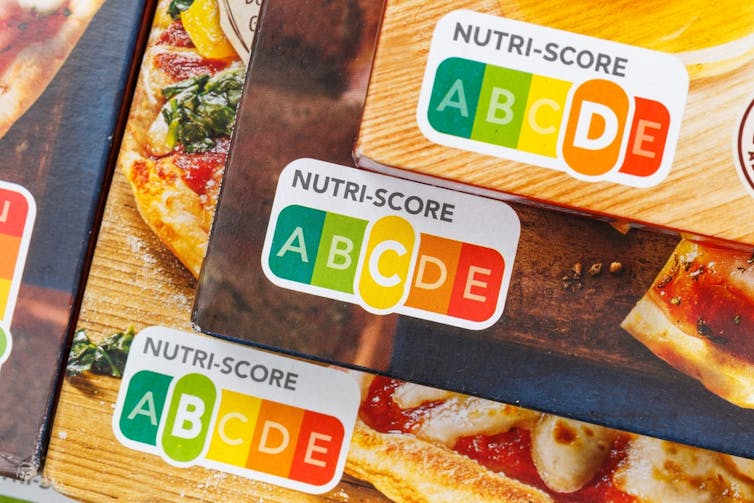Health star labels move closer to being mandatory. But food companies could still (legally) game the system

On Thursday, Australian and New Zealand food ministers at state, federal and national levels met to thrash out what’s next for health star ratings on packaged foods.
Now, after the food industry made slow progress in meeting the target to roll out health stars to more products voluntarily, ministers are tightening the screws.
In a significant step, they’ve just set in train a process to make health stars mandatory.
Here’s what this could mean for consumers, and what else we’d like to see.
A voluntary system isn’t working
Health star ratings are currently a form of voluntary, on-pack labelling intended to provide a simple, at-a-glance tool to help consumers compare similar packaged foods and make healthier choices.
But food ministers say the food industry is “significantly off-track” to meet targets for keeping health stars voluntary. The aim is for 70% of intended products to have a health star rating by mid-November 2025.
Statistics released in May this year show health stars were only on 32% of products in Australia and 30% in New Zealand that should be carrying them.
So the ministers’ decision yesterday to start preparing for mandating the system is a significant one.
Ten years of voluntary health stars have limited their value, with stars still missing from most labels. Uptake also remains skewed towards higher-scoring products. This reduces the stars’ potential to warn people about low-scoring, unhealthy food and drinks that play a leading role in driving chronic disease.
Will the food industry meet the 2025 target?
Overall, uptake of health stars in recent years has stalled or even declined slightly. So, given the food industry’s performance to date, chances are slim, at best, of it reaching the 70% target in 2025.
The George Institute’s annual independent monitoring suggests further adoption will require an about-face by some large manufacturers that have so far resisted using health stars. Hundreds of smaller manufacturers are also yet to come on board.
The fact that most products yet to show the rating would attract low scores makes it extremely unlikely the industry will meet the 70% target voluntarily.
The George Institute’s FoodSwitch program and app calculates the star ratings of products, regardless of whether food companies show it on the label. The image below shows the health stars of some popular products currently not labelled under the voluntary system. As you can see, they received low stars.
We worked out the health star rating of common foods that aren’t labelled.
The George Institute
What else we’d like to see
As well as allowing shoppers to make healthy choices, mandating health stars has other less visible, but equally important advantages.
Not only will governments no longer have to rely on the food industry to buy into the process, mandating health stars gives governments the chance to strengthen the system further.
The system currently scores foods using an algorithm, which was developed by a group that included the food industry. The algorithm deducts points for energy, total sugars, salt and saturated fat while rewarding protein, fibre, fruit, vegetable, nut and legume content.
Our work has previously shown the algorithm scores products right most of the time. Despite this, there is room for improvement.
Manufacturers can “game” the current system by adding fibres, proteins and artificial sweeteners to push their rating higher. This creates a “health halo” effect where products appear healthier than they really are.
These fibres, proteins and sweeteners are markers of ultra-processing, as they would not normally be found in those foods at those levels. Diets high in ultra-processed foods increasingly associated with a raft of serious long-term health problems.
In recent weeks, we showed factoring in ultra-processing in how health stars are calculated could reduce the scores given to many of these problematic foods, such as sugary cereals, refined white breads and diet soft drinks.
While ministers have not included an algorithm review in their next steps, periodic reviews will be necessary to ensure stars remain up-to-date with evolving nutrition science.
They must also follow World Health Organization guidance by ensuring they are conducted by an independent expert group without industry interference.
There’s also much we could learn from a decade of global labelling progress to refresh and improve the appearance of stars on packaged food.

Australian labels could be in colour and placed more prominently, as happens in Europe with its Nutri-Score labelling.
Markus Mainka/Shutterstock
Europe’s Nutri-Score system, for example, is similar but rates foods overall from A-E with the addition of red, orange and green to enhance messaging to consumers. Australian research has already shown health stars could equally benefit from the use of meaningful colours.
Other potential best-practice improvements include dictating where on the pack health stars would be, reducing competing nutrition claims such as “high protein” or “low sugar” and removing child-directed marketing from low-scoring packages.
We need to be ready
Some 25 Australian and New Zealand public health and consumer groups have been calling for mandatory health stars to maximise the policy’s benefits as a public health tool.
Now, work on preparing for this needs to progress urgently. Drafting new laws takes time. So starting work now means a mandatory program can be implemented swiftly if the food industry fails to meet its 2025 target.






